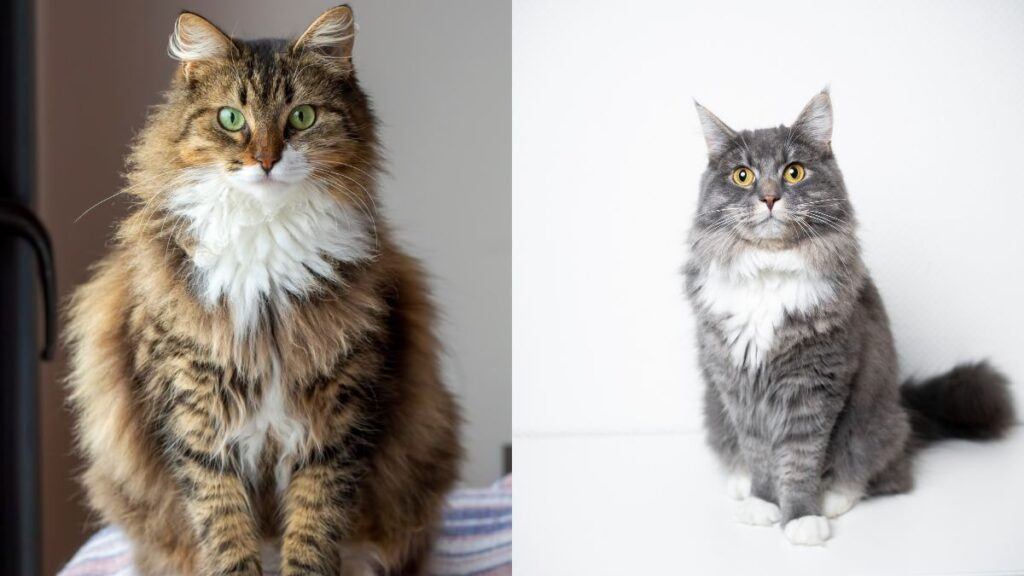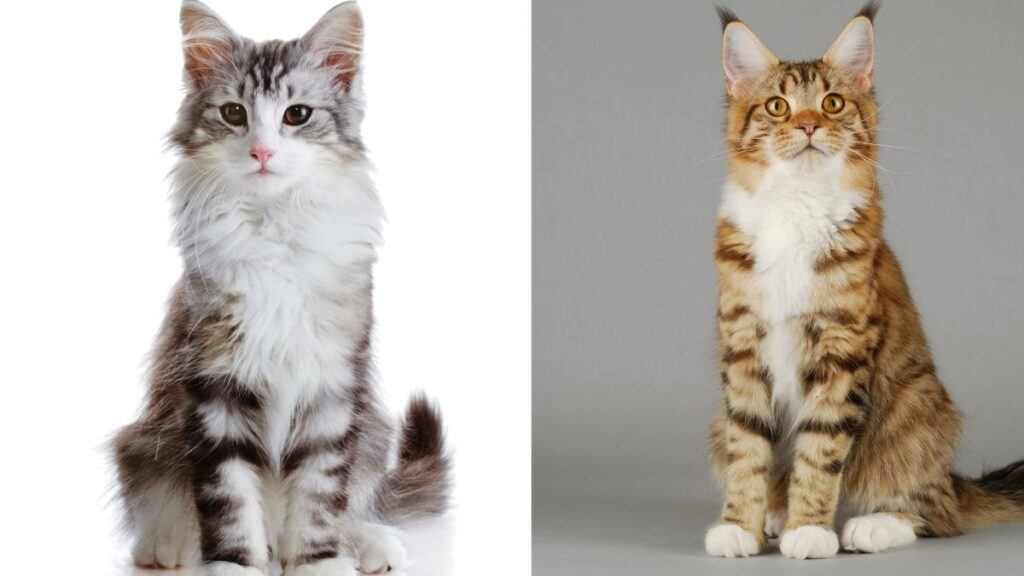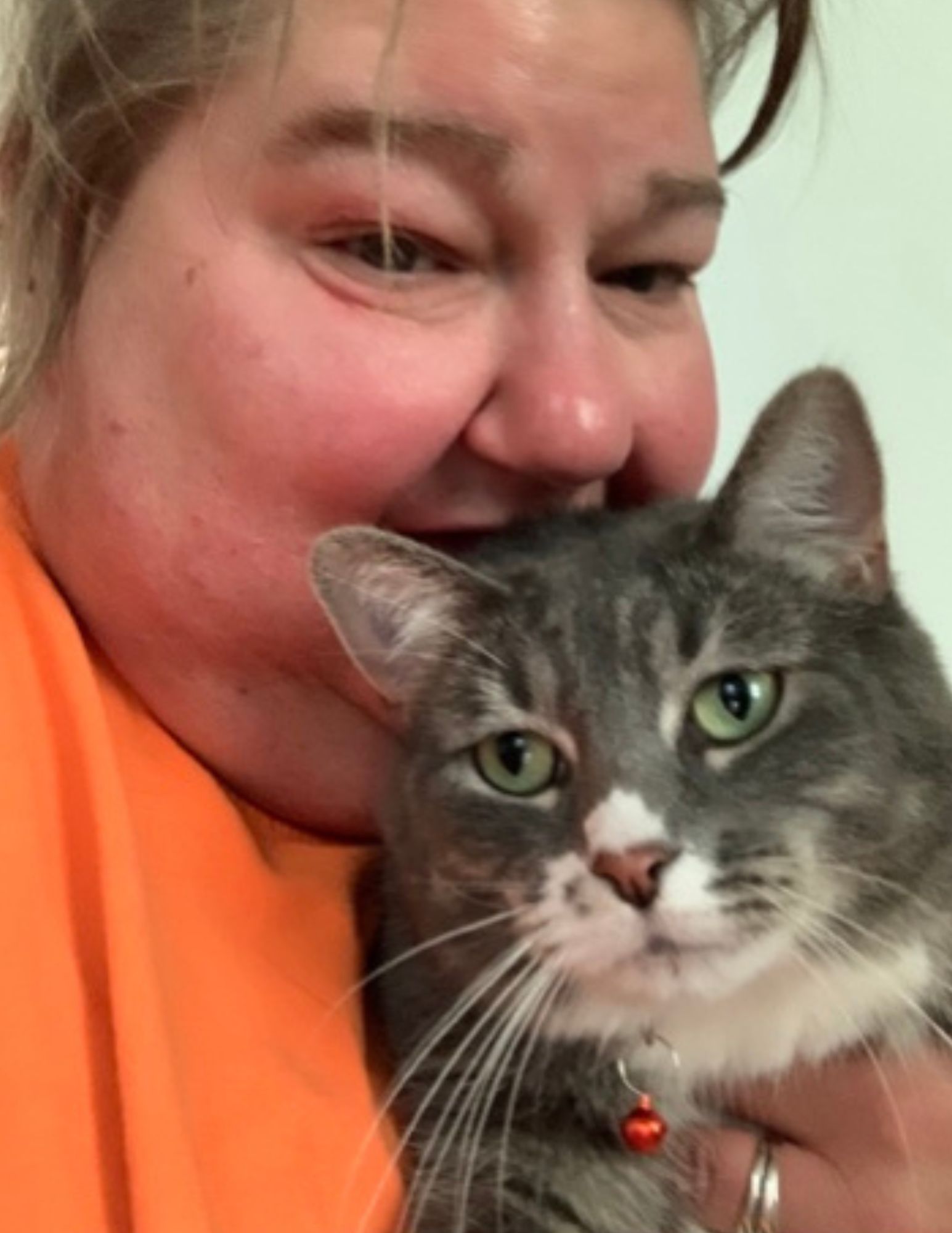In the world of feline enthusiasts, few breeds command as much adoration and awe as the Maine Coon and Norwegian Forest Cat.
Both revered for their majestic presence and distinguished heritage, these cats are a testament to the sheer diversity and splendor of domesticated feline breeds.
The Maine Coon, fondly known as the “gentle giant” of the cat world, originates from the rugged terrain of North America, particularly the state of Maine.
With its long, tufted ears, bushy tail, and robust physique, this breed is uniquely suited to endure its origin’s cold and varied climate. Its gentle demeanor, combined with a playful and affectionate nature, has endeared it to countless households across the globe.
On the other side of the Atlantic, the Norwegian Forest Cat boasts a rich history rooted in Scandinavian folklore and legends.
Often considered the mythical cats of the Vikings, these felines are marked by their lustrous, thick coat designed to protect against the biting cold of Scandinavian winters. Their piercing eyes and elegant stature speak of forests, fjords, and old tales.
When these two formidable breeds intertwine, the result is spectacular. The hybrid offspring encapsulates the Norwegian wilderness’s rugged allure and the Maine hinterlands’ warm-hearted essence.
To behold such a cat is to witness a living fusion of two incredible histories bound together by the universal charm of the feline spirit.
Related: Do Maine Cats Have an M on their Forehead?

Origins and History of the Maine Coon Cat:
- Native to North America: The Maine Coon cat is believed to be native to North America, specifically the northeastern region. The breed’s name is derived from The State of Maine, where it was first recognized as a distinct breed. The “Coon” part of the name is said to have been added because the species resembles the raccoon, although genetically, they aren’t related.
- Folktales and Myths: The exact origins of the Maine Coon are shrouded in mystery, leading to several charming but likely apocryphal tales. One of these suggests that the Maine Coon descends from cats sent to America by Marie Antoinette during her plans to escape France during the French Revolution. These cats supposedly interbred with local feral cats, leading to the Maine Coon. Another popular legend is that the Maine Coon is the result of breeding between domestic cats and raccoons. While this is biologically impossible, the Maine Coon’s bushy tail and color patterns may have led to this misconception.
- Viking Connection: Some researchers and cat enthusiasts believe that the Maine Coon might be descended from long-haired cats brought over by Norse explorers in the 11th century. The presence of similar-looking cats in Nordic regions and some genetic connections lends some weight to this theory, but it’s far from conclusive.
- Physical Adaptations: The Maine Coon’s physical characteristics reflect its adaptation to the harsh New England climate. Their thick, water-resistant fur, bushy tail, which they can wrap around their body for warmth, and tufted ears all helped them survive in cold conditions.
- Popularity and Recognition: In the late 19th and early 20th centuries, Maine Coons were very popular and were frequently showcased at cat shows in Boston and New York. However, their popularity waned with the introduction of other long-haired breeds. It wasn’t until the 1950s and 1960s that breeding programs began in earnest, and the breed’s popularity rose again. In 1985, the Maine Coon was declared the official state cat of Maine.
- Today: The Maine Coon remains one of the most popular and beloved cat breeds in the world. Known for their friendly, dog-like personalities, intelligence, and impressive size, these cats make excellent companions.
While the exact origins of the Maine Coon remain a mystery, their distinctive appearance and engaging personalities have ensured them a lasting place in the hearts of cat enthusiasts around the world.
Related: Maine Coon vs. Siberian: Similarities Between Both Cats

Origins and History of the Norwegian Forest Cat:
- Ancient Origins: The Norwegian Forest Cat has a lineage that traces back a thousand years in the cold Scandinavian regions. Ancient Norse tales and sagas feature large, long-haired cats that resemble the modern-day Norwegian Forest Cat, suggesting their presence in the area for many centuries.
- Viking Companions: There’s evidence to suggest that the Vikings kept these cats as pets, and they were also valuable aboard Viking ships for controlling the rat populations. Cats resembling the Wegie have been found depicted in Norse artwork, further supporting their longstanding association with the region.
- Survivors of the Forest: As their name suggests, Norwegian Forest Cats were natural hunters who thrived in the dense forests of Norway. Their thick, double-layered coat adapted to the cold, wet, and snowy environment, providing insulation and water resistance.
- Myth and Legend: Norse mythology has tales of the Skogkatt, a large, long-haired mountain-dwelling cat that was believed to be a fairy cat with the ability to climb sheer rock faces. The skogkatt is often considered an early reference to the Norwegian Forest Cat.
- Recognition as a Breed: Despite their ancient lineage, Norwegian Forest Cats were only officially recognized as a distinct breed in the 20th century. They became popular in Europe during the 20th century, and breeding programs began in the 1970s. The breed was officially recognized in Norway by the 1930s and in other parts of the world in the following decades.
- National Symbol: In 1977, King Olaf V of Norway named the Norwegian Forest Cat as Norway’s national cat, solidifying its place in the nation’s cultural history.
- Endangered Status: After World War II, the breed’s numbers declined significantly, almost leading to its extinction. Thanks to concerted breeding efforts by Norwegian cat enthusiasts in the 1970s, the breed was revived and is now well-established.
- Modern Day: Today, the Norwegian Forest Cat is adored for its friendly nature, intelligence, and distinct appearance. Their long, tufted ears, bushy tail, and muscular build set them apart. They have a calm and gentle temperament, making them great companions in homes worldwide.
The Norwegian Forest Cat, with its rich history and majestic appearance, is a testament to nature’s ability to sculpt animals to their environments. Its ties to Viking lore and Norse mythology only add to the mystique and allure of this beautiful breed.
Related: Manx Maine Coon Mix Cat: A Stubby Tailed Feline Breed

Maine Coon Health Concerns:
Hypertrophic Cardiomyopathy (HCM):
- HCM is the most common form of heart disease in cats, and it is prevalent in Maine Coons.
- It is characterized by the thickening of the heart muscle, which can lead to heart failure.
- Some Maine Coons may have a genetic predisposition to HCM, and genetic testing can identify specific risk factors.
Spinal Muscular Atrophy (SMA):
- SMA is a genetic disorder that affects the spinal cord’s motor neurons, leading to muscle wasting and weakness.
- Fortunately, it is not painful and affected cats often live everyday lives, albeit with some physical limitations.
- A genetic test can identify carriers and affected kittens.
Norwegian Forest Cat Health Concerns:
Hip Dysplasia:
- Hip dysplasia is less common in cats than dogs but can occur in larger breeds like the Norwegian Forest Cat.
- It involves an abnormal formation of the hip socket, which can lead to lameness or arthritis.
- Weight management and joint supplements may help mitigate symptoms, and in severe cases, surgery might be necessary.
Related: Why is my Cat so Small? Understanding Feline Growth Patterns
Common Concerns for Both Breeds:
Polycystic Kidney Disease (PKD):
- PKD is a hereditary condition where cysts develop in the kidneys, leading to renal failure.
- This condition is seen in both Maine Coon and Norwegian Forest Cats, though it’s more often associated with Persian and related breeds.
- Regular veterinary check-ups can help detect PKD early.
General Care to Mitigate Health Issues:
- Regular Vet Check-ups: Routine examinations can catch the early signs of these conditions. For breeds prone to HCM, regular cardiac evaluations are recommended.
- Genetic Testing: Where available, genetic testing can help identify if a cat is likely to develop certain hereditary conditions, allowing for early intervention and informed breeding practices.
- Diet and Exercise: A well-balanced diet and regular physical activity can help manage weight and reduce the risk of health issues like hip dysplasia.
- Hydration: Adequate water intake is important to support kidney function and overall health. Providing fresh water and wet food can promote hydration.
- Environmental Enrichment: Mental stimulation through play and interactive toys can support overall well-being and help prevent obesity.
While Maine Coon and Norwegian Forest Cats may have predispositions to certain health conditions, responsible breeding, awareness, and proactive healthcare can significantly enhance their quality of life. Owners should work closely with veterinarians to establish health routines that suit their cats’ needs.
Related: Maine Coon Cat Lifespan: The Longevity of the Gentle Giants
Maine Coon vs. Norwegian Forest Cat – Key Differences
| Feature | Maine Coon | Norwegian Forest Cat |
|---|---|---|
| Origin | State of Maine, USA | Norwegian Forests |
| Head Shape | Broad with a square muzzle, and high cheekbones | Triangular-shaped head with a straight profile and strong chin |
| Eye Shape | Almond-shaped, set at a slight angle | Typically 9-15, years, can live into their late teens with good care |
| Ear Characteristics | Extensive and tufted, broad at the base, tapering to a point | Large with tufts, broad at the base with a high set |
| Coat Texture | Shaggy, silky to the touch, and uneven in length | Dense, water-resistant with a woolly undercoat and smooth overcoat |
| Tail | Long, bushy, and flowing | Long and bushy, but the fur is more even in length |
| Body Type | Muscular, broad-chested, with a rectangular body shape | Strong, with a long body and sturdy bones |
| Personality | Friendly, playful, known for being dog-like in loyalty and trainability | Independent but affectionate, intelligent, and playful |
| Vocalization | Known for a distinctive trill and chirping sound, vocal but not loud | Quieter than the Maine Coon, with soft voices |
| Common Health Issues | Hypertrophic cardiomyopathy, Spinal muscular atrophy | Hip dysplasia, Polycystic kidney disease |
| Lifespan | Typically 9-15 years, can live into their late teens with good care | Usually 14-16 years, with some reaching 20 years with proper care |
Additional Information:
- Maine Coon: Maine Coons have a rugged appearance with their uneven, shaggy coats. Their personality is friendly and people-oriented, making them excellent family pets. They are often known for their affinity for water and may enjoy playing with water dishes or faucets.
- Norwegian Forest Cat: Norwegian Forest Cats are well-equipped for the Scandinavian cold, with their dense, insulated coats. They are known to be good climbers and often enjoy high perches. While they are affectionate, they can be more independent than Maine Coons and may not demand constant attention.
Care and Interaction:
- Exercise: Both breeds benefit from regular exercise. Maine Coons may be more interactive and enjoy fetch-like games, while Norwegian Forest Cats may prefer climbing structures or high vantage points.
- Grooming: The Maine Coon’s coat may require regular grooming to prevent tangles, especially around the neck and rear. The Norwegian Forest Cat’s coat is also dense, but it is designed to be water-resistant and may not mat as easily; still, regular grooming is beneficial.
- Healthcare: Regular health checks are essential for both breeds. Screening for their common health issues is recommended, as well as maintaining a healthy weight to reduce stress on the heart and joints.
While both the Maine Coon and Norwegian Forest Cat are large, pleasant breeds that make great companions, their physical differences particularly in coat and body structure.
Along with subtle personality differences, can help potential owners decide which might be the better fit for their home and lifestyle.
Norwegian cats, specifically the magnificent Norwegian Forest Cat, hold a special place among large cat breeds with their long hair and their status as the official cat of Norway.
These feline friends boast a stunning presence, combining rugged beauty and affectionate temperaments, making them a beloved choice for families seeking a large, long-haired companion.
The Maine Coon and the Norwegian Forest Cat, while being similar breeds, exhibit their own unique characteristics and are often considered two of the most magnificent cat breeds.
Both have dense coats and bushy tails suited for colder climates, but there are main differences in their physical features and terms of personality.
The Maine Coon, a natural breed from the State of Maine in the USA, often presents with a distinct look that includes a square muzzle and large ears, as well as a shaggy coat known as the “Maine Shag.”
Their flat forehead and large size contribute to the breed’s striking appearance. Maine Coon mixes often retain some of these standout features, though purebred Maine Coons are recognized by the International Cat Association for their particular breed standards.
Norwegian Forest Cats, in contrast, are thought to be a descendant of the Norwegian forest cat, a term that encapsulates their origins.
Their head is wedge-shaped, with a straight nose, and they carry themselves on powerful hind legs. The Norwegian Forest Cat size is large, but they possess a grace that belies their sturdy build.
Both breeds can share common ancestors, as seen in Norwegian Forest Cat mixes or Maine Coon mixes.
Cat owners treasure these large breeds of cats not only for their physical attributes, which include different colors and a dense top coat, but also for their warm interaction with family members, including young children.
Both are known to be gentle giants, often showing affection in their own way, with the Maine Coon sometimes being referred to as ‘coon cats’ in affectionate shorthand.
When comparing the two, it’s interesting to note that male Maine Coons can be particularly large, while the Norwegian Forest Cat’s size is uniform across the breed.
These cats have similar traits, such as their large ears and love of exploration, which likely stem from their shared heritage as rugged cats that had to survive in demanding environments.
Their health is of utmost importance to cat owners, and both breeds require much time and attention regarding their care.
While they may face medical conditions related to their large size, such as hip dysplasia for the Norwegian Forest Cat and hypertrophic cardiomyopathy for the Maine Coon, these issues can often be managed with the best cat foods and regular veterinary care.
For those looking to bring a new feline friend into their home, Norwegian Forest Cat kittens and Maine Coon kittens offer an opportunity to raise a natural breed known for their friendly nature and compatibility with young children.
Related; Maine Coon Tabby Mix Short Hair: Characteristics and Care Tips
| Feature | Maine Coon | Norwegian Forest Cat |
|---|---|---|
| Head Shape | Square muzzle, flat forehead | Wedge-shaped head, straight nose |
| Coat | Shaggy, “Maine Shag” | Dense, water-resistant |
| Personality | Sociable, affectionate, dog-like | Independent but loving, gentle |
| Size | Very large, especially males | Huge, especially males |
| Suitable for Families | Yes, especially with young children | Yes, good with family members |
| Official Recognition | International Cat Association | Official cat of Norway |
| Common Health Issues | Hypertrophic cardiomyopathy | Hip dysplasia |
Both the Maine Coon and the Norwegian Forest Cat make excellent companions for those who have the space and time to cater to these larger-than-life personalities.
Whether you opt for the friendly Maine Coon or the majestic Norwegian Forest Cat, you’re sure to have a rewarding experience with these fantastic creatures.
Choosing the better choice between the two ultimately depends on the prospective cat owner’s personality and care requirements preferences.
While the Maine Coon and the Norwegian Forest Cat have similar traits, origins rooted in colder climates, and are both long-haired cats, the two breeds are distinct in their own right.
Whether you’re drawn to the almond-shaped eyes of the Maine Coon or the history of the Norwegian Forest Cat tied to Viking tales, choosing between these feline friends is a delightful dilemma for any cat lover.
If you’re looking to understand more about other similar breeds like the Siberian cat or delve deeper into Maine Coon mixes or Norwegian Forest Cat kittens, you’re in the right place.
As with any purebred cats or mixes, always ensure that health concerns are addressed, the best care is provided, and time is cherished with these gentle giants.

Meet Ann Haasnoot, the passionate founder of CatFurLife.com. A lifelong cat lover from Wisconsin, Ann combines her extensive feline behavior and care knowledge with her love for writing. On her website, she shares invaluable insights about cat breeds, care tips, and her experiences with her beloved furbaby, aiming to deepen the bond between cats and their human companions.

